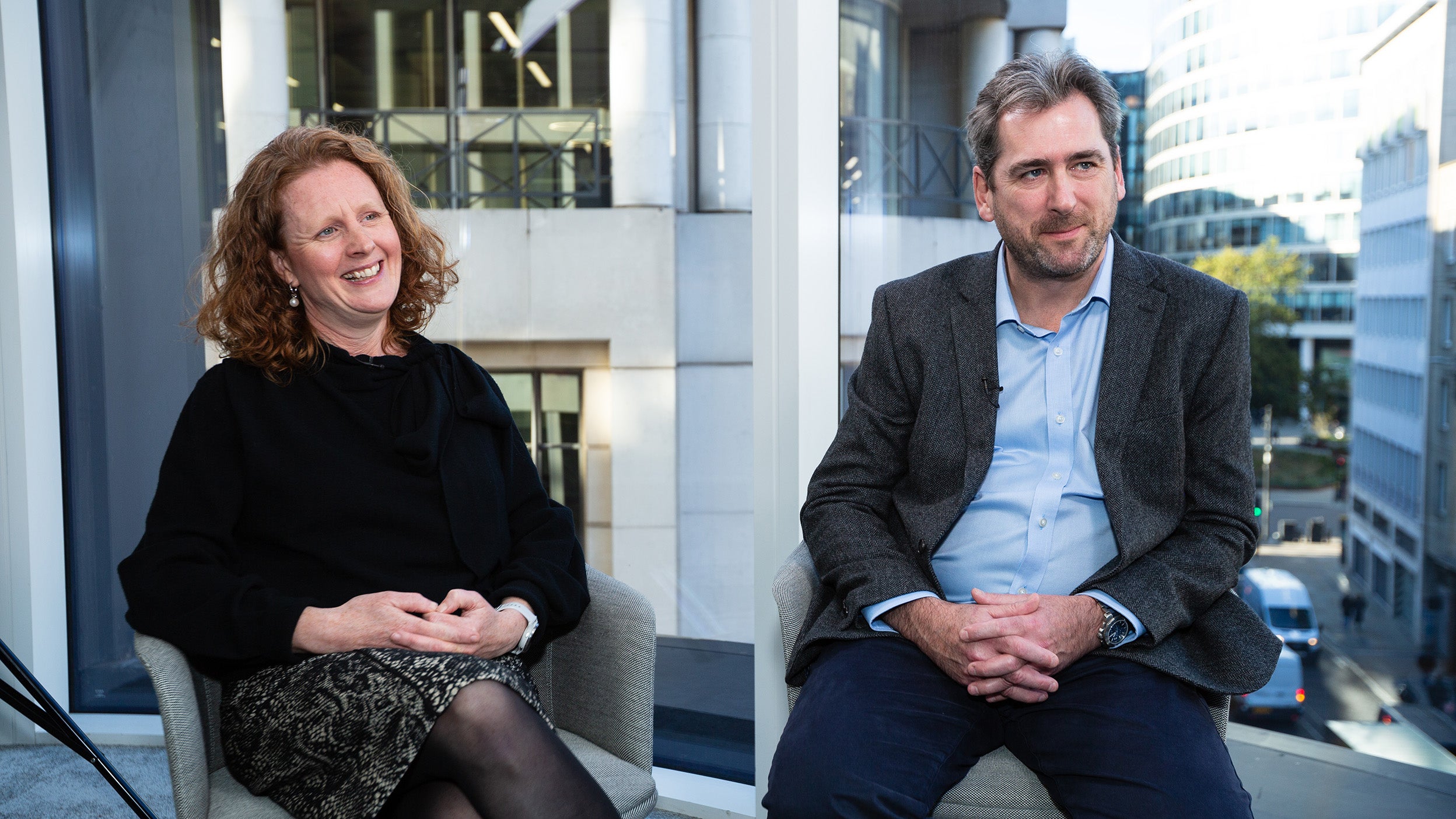
Private credit Key takeaways from our 2026 annual investment outlook webinar
Experts from equities, fixed income, real estate, alternatives, and more discuss where they see opportunities and risks in 2026.

Our recent DC roundtable brought together senior leaders and asset owners to explore the evolving role of fixed income in defined contribution (DC) pensions. Set against a backdrop of macroeconomic uncertainty, regulatory reform, and shifting member expectations, the discussion revealed a sector in transition - one that is embracing innovation, rethinking traditional allocations, and striving to deliver better outcomes across the member journey. We had significant representation from the DC market, with several hundred million in DC assets across People’s Pension, Scottish Widows, Standard Life/Phoenix Group, Smart, and NatWest Cushon.
“With so much innovation afoot across the DC market in terms of AI and private market investments, with the capacity to materially support both member engagement and investment outcomes to and through the retirement journey, this is a particularly valuable moment in time for collaboration across peers within the industry and we are grateful to Invesco for the opportunity.” Heather Coulson at Scottish Widows.
Rob Waldner, Head of IFI Strategy and Macro Research, opened the session with a macroeconomic overview that captured the complexity of the current environment. US growth is expected to slow, driven by a tightening labour market and persistent inflation. Interest rates are likely to remain elevated, and the US dollar is facing medium-term weakness as global investors diversify away from US assets. Fiscal concerns, including a growing deficit now exceeding 6% of GDP, are adding to the uncertainty.
Yet amid this turbulence, fixed income has emerged as a resilient and attractive asset class. Emerging market local currency bonds have performed particularly well, with notable gains since 20231, and global bonds are drawing renewed interest. For active managers, this is an opportunity-rich environment, one that could reward agility, diversification, and a willingness to look beyond traditional allocations.
“We believe that mainstream credit offers great yields right now and provides lots of opportunity to maximise our mandates across US, UK, and European markets with duration flexibility. Additionally, semi-liquid credit offers a unique blend of yield, diversification, and flexibility bridging the gap between liquidity and long-term opportunity. However, our view is that any allocation must justify itself in terms of hurdle rates net of fees and must leave value in the hands of our members rather than managers.” Charlotte Vincent at People’s Pension.
The roundtable set out to explore how fixed income can be better deployed across the DC landscape, not just as a late-stage de-risking tool, but as a strategic allocation throughout the member journey.
Fixed income has re-emerged as a compelling asset class, with emerging market local currency bonds and global bonds performing strongly. For active managers, the current regime offers opportunities particularly in global markets where valuations, yield curves, and currency dynamics are creating space for differentiated returns.
Regulatory reform is reshaping the DC landscape. The UK is positioning itself as a leader in pension innovation, with initiatives like the Mansion House Accord and the FCA’s targeted support framework pushing schemes to modernise. However, as several participants noted, regulatory change is outpacing behavioural change. While the frameworks are evolving, many schemes are still slow to adapt, particularly when it comes to diversifying away from traditional US-centric exposures.
Currency hedging emerged as a key area of debate. With the dollar weakening and portfolios becoming more globally diversified, the need for dynamic, flexible hedging strategies is growing. It could be beneficial to hold some currency exposure within portfolios due to its diversification benefits. One attendee noted, currency management will be “huge going forward,” especially as portfolios incorporate more private market assets.
“We believe being flexible and dynamic will be key going forwards, being able to make changes quickly in a rapidly evolving and complex world. Ultimately, we all need to be as unconstrained as possible to do the best for our members.” James Lawrence at Smart.
A central theme of the roundtable was the need to rethink how fixed income is deployed across the DC member journey. Historically it was viewed as a de-risking tool for those nearing retirement, fixed income is now being reconsidered as a strategic allocation throughout the journey.
Participants agreed that fixed income plays a vital role, but its form and function must evolve. In the early stages of the journey, liquid income-generating assets provided flexibility and stability. As members move closer to retirement, illiquid assets such as private credit offer diversification and the potential for enhanced returns through the illiquidity premium.
Private credit is gaining traction. Once confined to direct lending, the opportunity set has broadened significantly and is now being used to increase the resilience of portfolios. Participants highlighted the importance of blending these strategies to manage liquidity while still capturing upside potential.
“It’s important to explore investment opportunities across the entire credit spectrum, encompassing both liquid and illiquid assets. This will ensure we deliver the most effective strategy for our members' long-term financial needs.” Kinna Patel at NatWest Cushon.
The challenge lies in balancing liquidity needs with return objectives. Discussions revealed how semi-liquid structures are becoming increasingly attractive. They offer diversification without locking members in. This flexibility is essential in a world where members may need access to their funds at different points in their journey.
With public markets shrinking and private markets expanding, schemes are looking to build diverse alternatives buckets that include structured credit, private debt, and other non-traditional assets. The goal is to add capability, not complexity, ensuring that portfolios remain explainable and aligned with member outcomes.
“There is certainly a role for private credit to sit alongside more liquid portions of the portfolio to provide a diversified source of return. Our aim is to add capability, not complexity, with a keen eye on providing value for our members therefore fee structure is a key consideration. Our primary aim is to ensure portfolios remain explainable and aligned with member outcomes.” Chelsea Parandian at People’s Pension
While investment strategy was front and centre, the conversation repeatedly returned to the issue of member engagement. Despite advances in digital tools and mobile platforms, many members remain disengaged particularly at critical decision points. The 2022 gilt crisis was cited as a moment when better engagement could have made a meaningful difference.
We agreed that engagement must be proactive, educational, and tailored. It’s not enough to communicate investment decisions, members need to understand them. As one attendee put it, “we want to make sure every line is explainable to clients.” This means simplifying complex concepts like CLOs and private credit, and helping members see the long-term value of their pensions.
Technology is playing a key role in bridging this gap. From mobile apps to targeted support, digital transformation is making it easier for members to manage their pensions. However, the real challenge is encouraging long-term thinking and helping members see their pension as a journey, not just a pot.
A solutions mindset is essential. Rather than focusing on individual asset classes or regulatory constraints, schemes must think holistically, building portfolios that solve for investment risk, regulatory compliance, and member needs simultaneously.
The roundtable closed with a shared sense of purpose.
“I believe that investment decisions should be framed around the ultimate aim – to improve long term net returns for pension savers. Barriers to achieving that aim transform into challenges to overcome, rather than reasons to not embrace wider opportunities.” Callum Stewart at Standard Life.
It was great to see alignment across everyone at the table; while each provider is on a different path, the direction is clear: build balanced, flexible portfolios that deliver value across the entire member journey. At Invesco, we believe in the power of embracing innovation, rethinking traditional allocations, and collaboration, all while putting member outcomes at the heart of every decision.
The industry is on a journey to transition portfolios and align with new expectations. The challenge is significant but so is the opportunity. With the right partnerships, strategies, and mindset, the DC sector can rise to meet it.
We are dedicated to delivering customised DC investment solutions and strategies, thought-provoking insights and tools, and responsive client service to support our shared goal: helping members achieve a comfortable retirement.

Experts from equities, fixed income, real estate, alternatives, and more discuss where they see opportunities and risks in 2026.

Discover our Global Fixed Income Strategy Monthly Report, we offer an outlook for interest rates and currencies and look at which fixed income assets are favoured across a range of market environments.

As economies show resilience, selectivity and care remain critical for bond investors figuring out where to take duration risk and how to think about returns.